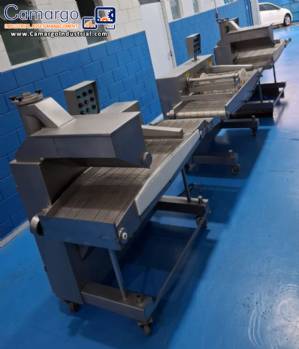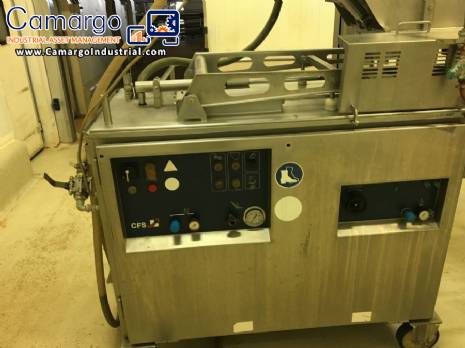Breading machines are industrial equipment designed to apply a coating of flour or dry mix to food, usually in the breading process. The breading process involves applying this coating, which is a crucial part of producing breaded foods, such as chicken, fish, vegetables or meat fillets, so that they become crispy when fried or baked.
A breading machine is a machine used to automate the breading process by applying an even layer of flour or breadcrumbs (breader) to food, such as meat, chicken or fish fillets, before they are fried or baked. The purpose of the breading machine is to ensure that the food has a consistent, crispy coating that will provide texture and flavor to the final product.
Breading process:
The breading process refers to the method of breading or coating a food with a dry mix, usually breadcrumbs or special flour. In the food industry, this is done to improve the texture, flavor, and appearance of the food, as well as to help maintain the internal juiciness of the product after frying or baking.
Steps in the breading process:
- Food preparation: The food is prepared (usually cut into pieces or fillets) and often dipped in a liquid mixture, such as beaten egg or a batter solution, before being breaded.
- Breading: After preparation, a layer of flour or breadcrumbs (breader) is applied to the food. The goal is to completely coat the food to ensure an even, crispy layer during frying.
- Frying or baking: After applying the breader, the food is fried or baked, creating a crispy crust that envelops the product.
Breading can be made with different types of flour (wheat flour, panko, breadcrumbs, etc.) or specialized mixes that ensure the desired crispy texture.
Types of breader flour applicators:
There are different types of breader flour applicators, each with specific characteristics depending on the production and type of product to be breaded. Some of the most common types are:
- Dry layer breader applicator:
This type of applicator is used to apply a layer of flour or breadcrumbs (panko, for example) directly onto the food. The flour is distributed evenly, usually through vibrating or rotating systems, to ensure that the food is well breaded.
- Liquid and dry layer breader applicator (double breading):
In this type of system, the food is first passed through a liquid layer (such as egg or a liquid batter), and then the breader applicator applies the layer of flour or breadcrumbs onto the food. This process is ideal for products that require a thicker layer of breading.
- Breader applicator with rotation system:
The food is placed in a rotating drum or cylinder where the breader is applied evenly. This system is efficient for large volumes of products and allows for uniform breading.
- Spray breader applicator:
A spray system applies a thin layer of flour or breader onto the products. This can be used when a lighter layer of breading is desired.
Advantages of the breader flour applicator:
- Uniformity and consistency:
The main advantage is the uniform application of the breader, ensuring that each piece of food has the same thickness of breading, which improves the presentation of the final product.
- Increased productivity:
By automating the breading process, breader applicators increase production efficiency, allowing large volumes of food to be breaded quickly.
- Reduced waste:
Using an applicator reduces waste of flour and breading agent, as the application is controlled, ensuring that only the necessary amount of flour is used.
- Reduced labor:
With process automation, the need for manual labor is reduced, which contributes to lower operating costs and improved food safety.
- Better control of product quality:
Automated breading allows greater control over the thickness and quality of the breading agent layer, resulting in a more uniform, crispy and better-looking final product.
Industries that use breader flour applicators:
Breader flour applicators are widely used in various food industries, especially those that produce breaded or processed foods. Some of the industries that most often use this type of equipment include:
- Frozen food industries:
Manufacturers of frozen foods, such as chicken nuggets, breaded fillets, breaded fish, and other breaded products, use these machines to automate the breading process.
- Fast food industries:
Large-scale restaurants and fast food chains that produce large volumes of breaded foods, such as fried chicken and breaded fish, also use breader flour applicators to ensure uniform and efficient breading.
- Meat and fish processing industries:
Companies that process meat or fish, including those that produce breaded fillets or similar products, use breader flour applicators to ensure consistent and efficient coating.
- Ready-to-eat food industries:
Manufacturers of ready-to-eat meals and food products for supermarkets, such as frozen meals that include breaded foods, also use these machines to increase production and improve food quality.
- Vegetarian or alternative product industries:
Industries that produce breaded plant-based alternatives, such as plant-based burgers, breaded tofu or other similar products, also benefit from the use of breader flour applicators.
In short, breader flour applicators are essential for large-scale production of breaded foods, offering advantages such as greater uniformity, efficiency, reduced waste and quality control. They are widely used in various food industries, including frozen foods, fast food, meat and fish processing, and vegetarian products. The breading process is essential to ensure a crispy and tasty layer on foods, making these products more attractive and pleasant to the palate.
In addition, breader flour applicators are a type of breading machine. They are part of the breading process and are specifically responsible for applying a layer of flour or dry mix (breader) over the food. Their purpose is to ensure that the breading layer is evenly distributed, providing a crispy crust after the frying or baking process.
Difference between breader and empanada flour applicator:
- Breader flour applicator:
The main function of the breader flour applicator is to apply flour or dry mix (such as breadcrumbs, panko, wheat flour or others) over the food.
It can be part of a more automated production line that includes other stages, such as applying a liquid layer (such as egg or batter) before going through the application of flour.
It is mainly focused on the dry layer application stage, ensuring that the product has the desired coverage evenly.
- Breader:
The breader can be a more generic term that encompasses machines that apply both liquid layers (such as egg or batter) and dry layers (such as breadcrumbs or breader).
In a full breader, the process involves multiple steps, including dipping the food in a liquid mixture (usually beaten egg or a mixture of liquids), followed by the application of the dry coating (breading).
Many breaders have two stages: first applying the liquid and then the dry coating, ensuring a thicker, crispier crust.
In short, a breader is a breader, but it is a machine focused only on the dry coating part (breading), while a breading machine can involve both the application of the liquid and the dry coating in a more complete manner. Both are intended to create a crispy, even coating on foods before they are fried or baked. |





